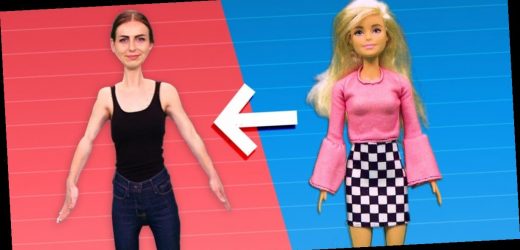- Research shows that dolls with unrealistic proportions, like Barbie, promote body dissatisfaction and low self-esteem among young girls.
- We set out to to discover how unrealistic Barbie's body is by scaling her up to the height of an average American woman.
- The most noticeable difference was in the waist. Barbie's was about 50 centimeters around, compared to the waist of an average American woman of 98 centimeters.
- In 2016, Barbie's maker Mattel released a handful of new sizes, including Curvy Barbie, which are more representative of real-life body diversity. But some experts say these dolls are still far from perfect.
- Visit Business Insider's homepage for more stories.
Following is a transcript of the video.
Ken: Hiya, Barbie!
Barbie: Hi, Ken! You're looking unrealistically thin today!
Ken: Funny, I was going to say the same about you.
Narrator: Barbie is one of the most popular dolls in America. But that doesn't mean that she's loved by everyone. For years, women advocates have criticized the doll for her proportions, which they say set unrealistic and damaging body expectations for young girls.
In response, her maker, Mattel, created a handful of new sizes in 2016, including Curvy Barbie. But how unrealistic is Barbie really? Is Curvy much better? And where does Ken fit into all of this? That's what we set out to discover.
Benji Jones: Hello, and welcome to our Barbie experiment. Today, we're going to open up each of these three dolls and do a little bit of math to try to figure out what they would look like if they were life-size. We have your more typical Barbie over here. We've got a Curvy Barbie, which is kind of a newer doll. And then, of course, we also have a Ken doll because I couldn't not get Ken. So let's get started.
Narrator: First, we measured each of the dolls, their height, waist, and so on, and used some high-school algebra to figure out their life-size measurements. Then, we compared them to a real-life woman for comparison: our colleague Jensen.
Jones: So Jensen, how tall are you?
Jensen Rubinstein: I am 5-3 and a half.
Jones: So you are the average height of an American woman, congratulations.
Rubinstein: Wow, thank you!
Jones: First thing we're gonna do is take some of your measurements.
Rubinstein: OK.
Jones:And then we're gonna compare that to Barbie. Will you point to your belly button for me?
Rubinstein: Right here.
Jones: OK.
Narrator: Although Jensen is the average height of an American woman, she has a smaller-than-average waist. But still, it's not nearly as thin as Barbie's. If we scale Barbie to life-size, her waist would be a mere 50 centimeters, and her hips, just 71 centimeters. And if Jensen had Barbie's proportions, this is what she would look like. She'd have shorter arms, a longer neck, and tiny feet. In fact, they'd be so small that she'd have trouble balancing and would be forced to walk on all fours.
And what about Curvy Barbie? Is she any more realistic? Actually, yes, at least relative to Jensen. Her waist would be around 63 centimeters and her hips around 90, the same as Jensen's. Now, here's Jensen with Curvy Barbie's proportions. Not that different. Though, of course, she still wouldn't be able to walk upright.
Now, we can't forget about Ken. This time, I stood in for comparison. If we scale Ken up to my height, his waist would be just 63 centimeters, and he would also have unusually small feet, long legs, and larger calves. But his biceps, well, mine are actually bigger. Uh, Ken, you better watch out.
So as you might expect, most Barbies look nothing like average Americans, as fit as they may be. In fact, researchers found that the chance of a woman having traditional Barbie's proportions is less than one in 100,000. And that's a problem.
Deborah Tolman: My name's Deborah Tolman. I'm a professor of critical social psychology and women and gender studies at Hunter College at City University of New York.
Narrator: And according to Tolman:
Tolman: Dolls actually have an enormous effect on girls' and boys' sense of themselves, their ideas about body, particular thin-body ideals. If you have an ideal, and you're never able to achieve it, you don't need a psychological study to show that it makes you feel bad.
Narrator: But there are plenty of studies that do. A study published in 2006, for example, found that young girls who are exposed to Barbie-doll images had more body dissatisfaction and lower body esteem compared to girls who were shown similar pictures of a larger-sized doll. But fortunately, it goes both ways.
Tolman: Playing with a more, I guess, quote, chubby doll actually suppresses the desire for a thin body. So thinking about it only as negative really doesn't tell the full story because there are ways that we can introduce dolls and play that will actually yield protective effects.
Narrator: And that's why some experts applaud Mattel for creating Curvy Barbie. But it's also led to a whole new business for people who want to make even more realistic dolls because let's face it, Curvy Barbie still doesn't depict the average American woman.
Nickolay Lamm: So Curvy, Tall, and Petite Barbie, like, I think it sounds good, like, "Oh, Curvy, Tall, and Petite, we're all diverse and everything." But if we actually look at their individual, each doll, each doll is still unrealistic because the Curvy is still like the perfect hourglass shape. The Petite is very extremely slim, and the Tall is basically like essentially the original Barbie, except kind of a little bit taller.
Narrator: That's Nickolay Lamm.
Lamm: I'm the founder of Lammily, which makes dolls with realistic body proportions to promote healthy body image.
Narrator: Lamm competes with Mattel for business, so of course there's some difference in opinion about the perfect doll, but if you look at his dolls, it's easy to see how they differ from Barbie, Curvy or otherwise. And in the end, maybe there is no perfect doll. After all, people come in all different shapes, sizes, and colors, and it's pretty clear that dolls should too.
EDITOR'S NOTE: This video was originally published in June 2019.
Source: Read Full Article


